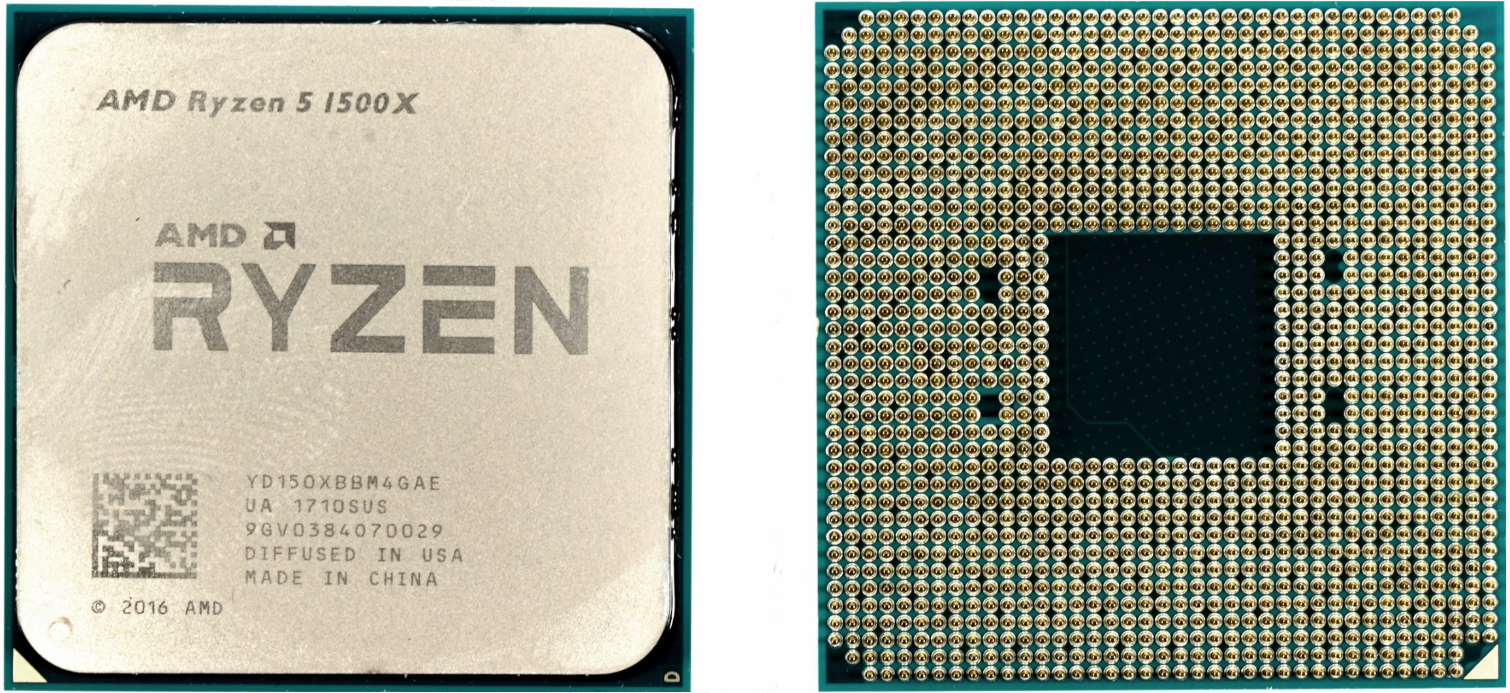AMD Ryzen 5 1500X CPU Review
Why you can trust Tom's Hardware
Final Analysis
Ryzen 5 1500X takes on Intel's Kaby Lake-based Core i5 CPUs with four cores of its own. But because the chip supports simultaneous multi-threading, it presents eight logical cores to your operating system.
| Row 0 - Cell 0 | Price Per Usable Core | Price Per Thread |
| Ryzen 7 1800X | $58.75 | $29.38 |
| Ryzen 7 1700X | $48.50 | $24.25 |
| Ryzen 7 1700 | $41.25 | $20.62 |
| Ryzen 5 1600X | $41.66 | $20.83 |
| Ryzen 5 1600 | $36.55 | $18.75 |
| Core i5-7500 | $48.00 - $50.50 | $48.00 - $50.50 |
| Ryzen 5 1500X | $47.25 | $23.65 |
| Core i5-7400 | $45.50 | $45.50 |
| Ryzen 5 1500 | $42.25 | $21.25 |
As you can see, AMD's Ryzen 5 1500X bears the family's highest cost per physical core. It lands in the same range as Intel's Core i5s, in fact. But the 1500X's value comes from the benefit of SMT technology. While this chip's cost per thread is also highest among the Ryzen 5 CPUs, the 1500X does become more competitive than Intel's offerings when you divide its price tag across eight threads. Of course, taking advantage of that extra functionality isn't trivial. But if your application does benefit from parallelization, Ryzen 5 1500X is positioned to capitalize.
Although price per thread is an interesting academic metric, the price to performance ratio is typically more meaningful. As an example, we don't like AMD's Ryzen 5 1600X much for gaming because it costs more than Core i5-7600K, and the Intel chip overclocks better to boot.
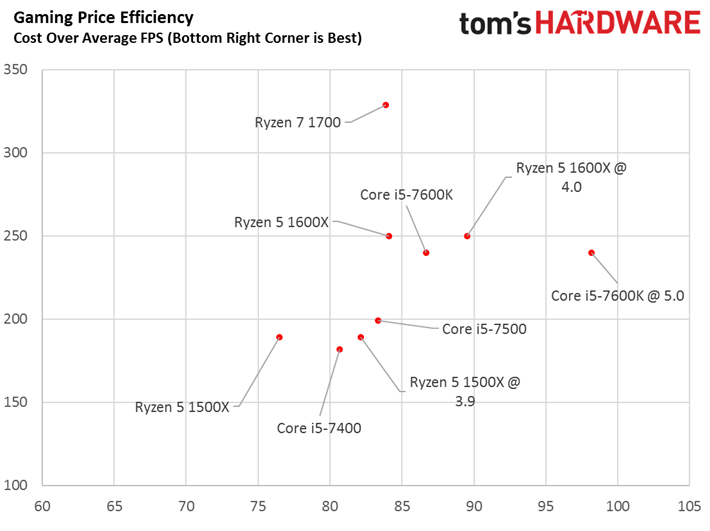
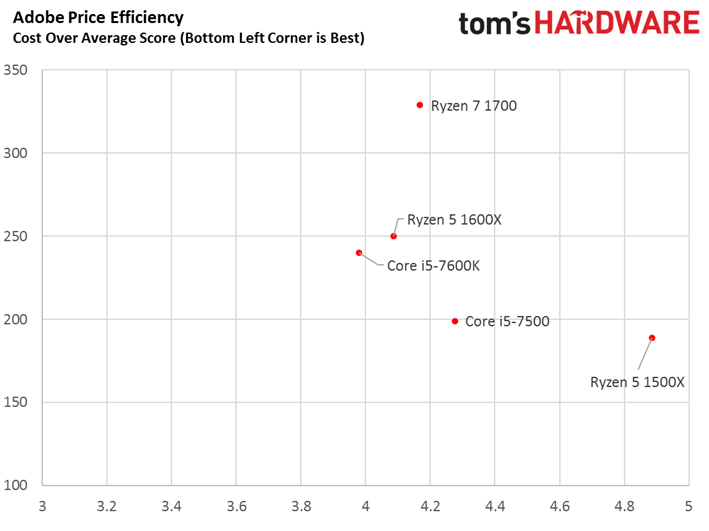
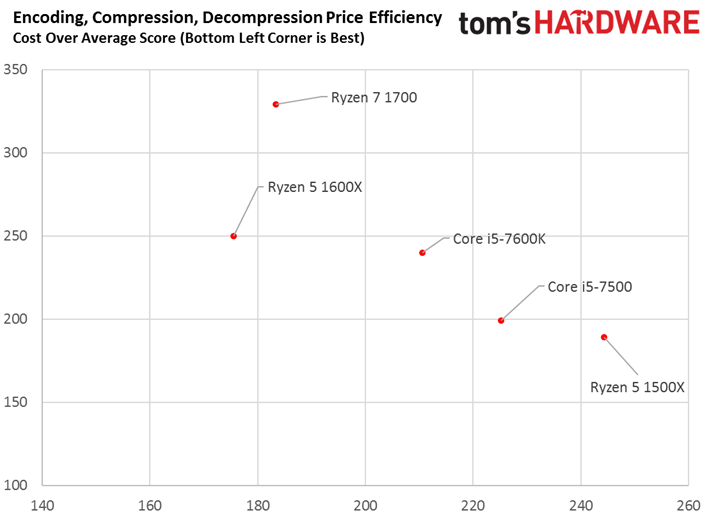
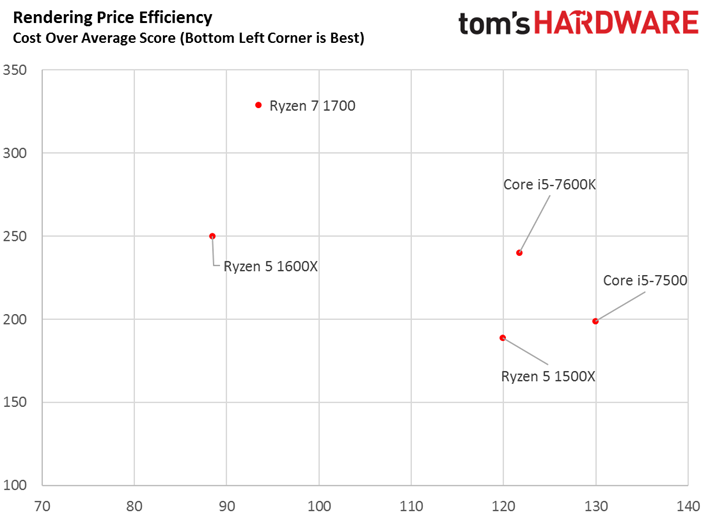
Because Intel stubbornly locks the multipliers on its non-K-series SKUs, though, cheaper Core i5s don't enjoy the same advantage against Ryzen 5 1500X. AMD's processor isn't a gamer's dream at its stock settings. But a little tuning puts the 1500X in contention with similarly-priced Intel CPUs. We experienced unflattering frame time spikes in some titles on the Core i5-7400, so an overclocked Ryzen 5 1500X provides a smoother experience in that regard. Overclocking also helps the 1500X against Intel's Core i5-7500.
The 1500X isn't as competitive in our Adobe and Encoding tests. Then again, we ran those benchmarks using stock clock rates. A bit of optimization would help AMD quite a bit, whereas the Core i5-7500 and -7400 are locked to their factory-set frequencies. Although Ryzen 5 1500X can't keep up with the six-core 1600X in these types of workloads, it's hard to beat for the price.
Ryzen 5 1500X and its Intel competition easily drop into affordable motherboards, and both include bundled coolers (though we suspect that AMD's Wraith Spire is the beefier solution). You do need to budget for a high-end memory kit if you want access to the 1500X's best performance, though.
By virtue of its four cores, Ryzen 5 1500X isn't as fast as higher-end Ryzen processors in heavily threaded applications. But it readily challenges Intel's Core i5s in those workloads. Where Kaby Lake claws its way back is single- and lightly-threaded tasks. Fortunately for AMD, once you get down to this price level, the Intel chips are limited by locked ratio multipliers. So overclocking proves powerful in changing the dynamic.
Get Tom's Hardware's best news and in-depth reviews, straight to your inbox.
Indeed, Ryzen 5 1500X relies on overclocking to make its story compelling. At stock settings, gaming PCs are better-equipped with the Core i5-7500. But the freedom to optimize helps AMD's 1500X serve up smooth frame rates with threads left over for dominating content creation workloads. The value of overclocking always weighs heavily on our recommendations, and Intel doesn't even qualify. AMD consequently gets the kudos for satiating enthusiasts across its portfolio.
If that sub-$200 price range is the top of your budget, Ryzen 5 1500X is a good alternative to Intel's locked Core i5s. An overclocked 1500X serves up better gaming performance than the Core i5-7400. Plus, its four extra logical cores provide a big boost in heavily threaded content creation apps, pushing AMD's chip out of front of Core i5-7500.
MORE: Best CPUs
MORE: Intel & AMD Processor Hierarchy
MORE: All CPU Content

Paul Alcorn is the Editor-in-Chief for Tom's Hardware US. He also writes news and reviews on CPUs, storage, and enterprise hardware.
-
IceMyth I think you missed the i5-7600K from the Price per Usable Core/Thread table which is $57.2 if you buy it from OutletPC but if you buy it from Amazon.com it will be ~$60.Reply -
Shale Be careful, your fingerprint is visible on the CPU, someone could get enough of it from that photo to print and form a latex fingerprint that could be used to frame you for a crime, or depending on the finger and usage, be used for security breach or unlocking your phone.Reply -
InvalidError Cost per 1% low FPS might be a better metric: emphasize sustainability. Maybe a 35-45-20 blend of average-1%-0.1%.Reply -
Wisecracker <50w in the gaming loop is impressiveReply
Great job overall by AMD, and would love to see a 'head-to-head' with an OC'd AM3+ rig (FX-6350 at 4.5GHz?)
Page 5 _ "Civilization VI Graphics Test" Heading
-- graphic says, "Resident Evil 7"
-
jkhoward It has been shown time and time again that the AMD chip when paired with a Nvidia card has poor performance. You should really consider getting an AMD Workstation card for your test until Nvidia can fix the issue.Reply -
velocityg4 Why didn't you use the same CPU options for both the Workstation and gaming tests? It would have been helpful to know how an overclocked 1500x stands up against an i5-7500 in any use case. If someone is overclocking for gaming. They aren't likely to disable the overclock when working.Reply
It sounds like Toms German and US labs need to communicate a bit more to set exact testing requirements for a review. That way the reader receives consistent data.
As it stands now. The review is haphazard. There are different data sources for gaming, workstation, temperature and power. -
elbert Looks like the Ryzen 5 1500X bests the i5-7500 while overclocked. Should the test have included best OC with the stock cooler? Price is important at this level and an aftermarket cooler stripes it of the price advantage.Reply
